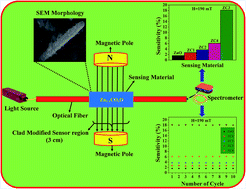Fiber optic magnetic field sensor using Co doped ZnO nanorods as cladding
Abstract
A fiber optic magnetic field sensor is proposed and experimentally demonstrated. Pristine and Co doped ZnO nanorods of different Co concentrations (5, 10, 15 and 20 at%) were synthesized using a hydrothermal method. The synthesized nanorods were subjected to various characterization methods like X-ray diffraction (XRD), optical absorption, scanning electron microscopy, energy dispersive X-ray spectroscopy, Fourier transform infrared spectroscopy, vibrating sample magnetometry and X-ray photoelectron spectroscopy (XPS). XRD and XPS analysis confirms that the Co ions were successfully incorporated into the Zn site of the wurtzite ZnO lattice without altering the structure. The pristine and Co doped ZnO nanorods showed remarkable changes in the M–H loop where the diamagnetic behavior of ZnO changes to paramagnetic when doped with Co. The sensor structure is composed of cladding modified fiber coated with Co doped ZnO nanorods as a sensing material. The modified cladding is proportionally sensitive to the ambient magnetic field because of the magneto-optic effect. Experimental results revealed that the sensor has an operating magnetic field range from 17 mT to 180 mT and shows a maximum sensitivity of ∼18% for 15 at% Co doped ZnO nanorods. The proposed magnetic field sensor would be attractive due to its low cost fabrication, simplicity of the sensor head preparation, high sensitivity and reproducibility.



 Please wait while we load your content...
Please wait while we load your content...